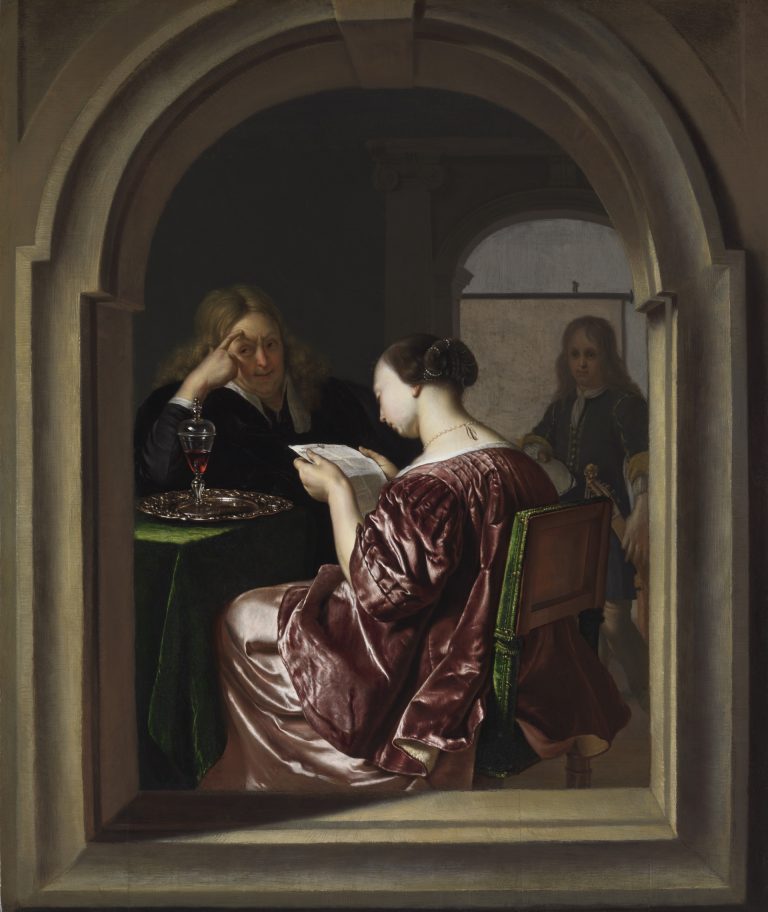Frans van Mieris was not only a master at rendering different materials, but also in depicting the relationships of people in domestic settings. Here he has portrayed a young woman quietly immersed in reading a broadsheet or newspaper she carefully holds in her hands while, opposite her, a man with a finger resting against his forehead in a thinking pose looks directly out at the viewer.1 Even though the two individuals are in close proximity, their activities and body language suggest that they are in their own separate worlds. There is a comparable difference of emphasis in the way they are depicted. The woman’s smooth skin is fully illuminated, and the artist carefully captured the folds and shimmering surface of her beautiful silk deep red jacket and copper-colored dress with numerous bright highlights. The man’s black outfit, however, is barely visible, which helps underscore the importance of his head and gesture. Van Mieris visually connects the two individuals with the exquisitely depicted glass of red wine and silver dish on the table between them.
Behind the couple is a monumental arched doorway leading to another room with a large map on the wall. Passing through the doorway is a young boy who carries a lute and some sheet music, motifs that suggest a romantic interlude may be on the gentleman’s mind. The composition, in this respect, is similar to Young Woman Playing a Harpsichord to a Young Man, ca. 1659 (London, National Gallery) by Jan Steen (1625/26–79).2 Lutes can be found in numerous paintings and prints from the sixteenth and seventeenth centuries, either as signs of intimacy or as references to women or the female genitals. Indeed, “to strike the lute” was a Dutch expression for sexual intercourse,3 something that would explain the pointed look on the man’s face.
The main protagonists in this painting are Van Mieris himself and his wife, Cunera van der Cock (1629/30–1700), called “Kniertje,” whom he had married in 1657, shortly after the birth of their first daughter, Christina (1657–85).4 The couple later had two sons and two more daughters, Anna (1658–1723) and Cornelia (1665–1751). The sons, Jan (1660–90) and Willem (1662–1747), both became artists, and perhaps one of them was the model for the boy in this painting. Later eighteenth-century descriptions of the painting, such as an entry in the 1768 catalogue of the Leipzig collector Gottfried Winckler (1731–95),5 confirm that collectors were aware of the fact that Van Mieris had used himself and his wife as models, something he did in no less than a quarter of his painted oeuvre.6
The stone window-framing device, which occurs in many of Van Mieris’s works, is considered the trademark of the Leiden fijnschilders. Nevertheless, this window frame is a later addition and was not part of the artist’s original concept.7 This added surround can be seen clearly in an X-radiograph (fig 1) and even with the naked eye.8 Remarkably, the X-radiograph also shows that Van Mieris painted his genre scene over a male portrait.9 Evidence for the fact that the window-framing device was a later addition comes from two painted copies and an engraving (fig 2) that show the painting in its original, smaller format.10 The engraving, by the little-known engraver Cornelis van Meurs (active before ca. 1720?), gives a date for Van Mieris’s panel of 1676, which is entirely appropriate for Van Mieris’s development.11
The window-framing motif appears to have been added by the artist’s son Willem van Mieris, who made a copy of the painting in 1687.12 He was probably also responsible for producing a “pendant” to this picture, A Man Drinking and a Woman Offering Him a Fish, which in the past was attributed to his father (fig 3).13 Willem van Mieris followed his father in choice of subject matter and technique, but his paintings are rather slick in execution. In A Man Drinking and a Woman Offering Him a Fish, the reflected light is a little hard and the figures are stereotypes.14 Between 1733 and 1764, both paintings are documented together in sales catalogues.15 The enlargement of the present picture must have been done before 1733, as the catalogue of the sale of the collection of Adriaan Bout gives the present dimensions, with the additions.
The provenance of Woman Reading and a Man Seated at a Table previously contained major lacunae. It can now be established, however, that the painting, which was described in the sales catalogues of the collections of Adriaan Bout and Benjamin da Costa,16 was later owned by the famous Leipzig banker Gottfried Winckler (1731–95). In the entry on the painting in the 1768 catalogue of Winckler’s collection, reference is made to the Da Costa collection.17 With this information, the vague reference to a subsequent owner, a “Mr Duval” from Geneva, can now be completely understood: he is the court jeweler Jean-François-André (François) Duval (1776–1854) from Saint Petersburg, who bought a major portion of Winckler’s paintings collection.18 Duval’s collector’s mark, “FD,” was also found on the back of this panel.19 In 1845 Duval sold his collection to Napoleon III’s half-brother, Charles-August-Louis-Joseph (1811–65), Duc de Morny, who lived in Paris but dispersed many of the newly acquired paintings in London a year later.20 The painting would stay in England for more than 150 years, until it was acquired by the Leiden Collection in 2008 from the heirs of the Marquis of Lansdowne.
